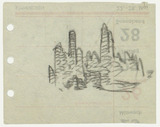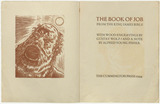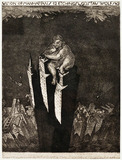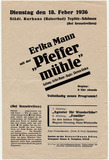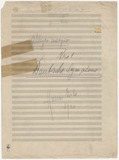Gustav Wolf: Letter to Lola Steiner (14 June 1939)
After his emigration to the United States, the painter and graphic artist Gustav Wolf had to earn a living by working for a period of time on a poultry farm. It was from there that in June 1939 he sent an illustrated birthday greeting to a student who had also emigrated to America, Leona Steiner, known as Lola.
Gustav Wolf: sketch of the Manhattan skyline on the back of a German calendar sheet (undated)
On 8 April 1938, Gustav Wolf emigrated from Germany, arriving by ship at his destination: New York. Artistically productive though by no means financially successful, in the following years the painter and graphic artist engaged with the subject of his new home.
Gustav Wolf: The Book of Job, woodcut illustration (1943/44)
In the summer of 1942, the artist Gustav Wolf left the metropolis of New York, which he so hated, and moved to the countryside. His friend, the emigrant Jacob Picard, had advised him to come to Cummington, Massachusetts.
Gustav Wolf: Vision of Manhattan, graphic series (1942)
In 1942 Gustav Wolf published a twelve-part graphic series on his former residence: Manhattan. The motifs do not make cheerful viewing.
Handbill for the Pfeffermuehle (Pepper Mill) Cabaret's tour of the Czechoslovakian Republic (1936)
In 1935 and 1936, the Pfeffermühle Cabaret completed three tours of the Czechoslovakian Republic. A number of these performances took place under difficult circumstances in a heated political atmosphere.
Handwritten notes by Max Reinhardt on A Midsummer Night's Dream (1935)
Max Reinhardt's production of Shakespeare's A Midsummer Night's Dream in 1934 at the famous 18,000-seater "Hollywood Bowl" was a huge success. William (Wilhelm) Dieterle had the idea of making a film from the stage work; he was a pupil of Max Reinhardt and at this time under contract as a director at Warner Bros.
Hanns Eisler / Ernst Busch: Das Moorsoldatenlied (Peat Bog Soldiers; 1937)
A song goes around the worldThe Moorsoldatenlied (Peat Bog Soldiers) is one of the world's most famous resistance songs. It was not only sung by its creators, the prisoners of the Börgermoor concentration camp in Emsland. The text and musical score were smuggled out of the camp, copied multiple times, translated and reinterpreted.
Hanns Eisler: Birthday canon for Lion Feuchtwanger, manuscript (1944)
The composer Hanns Eisler and his wife Lou arrived in Los Angeles in April 1942. They had relocated from New York because Eisler harboured hopes of landing music composition work in the Hollywood film industry.
Hanns Eisler: Deutsche Sinfonie [German Symphony], music score (1938)
Hanns Eisler carried out his work on the German Symphony in different phases of his life. He began it on his first big concert and lecture tour of the USA in 1935.
Hanns Eisler: Letter to the director Erwin Piscator (11 August 1941)
In a letter to the director Erwin Piscator, the composer Hanns Eisler expresses his concern regarding writer Bertolt Brecht. He had arrived in the US via Finland in July 1941.


